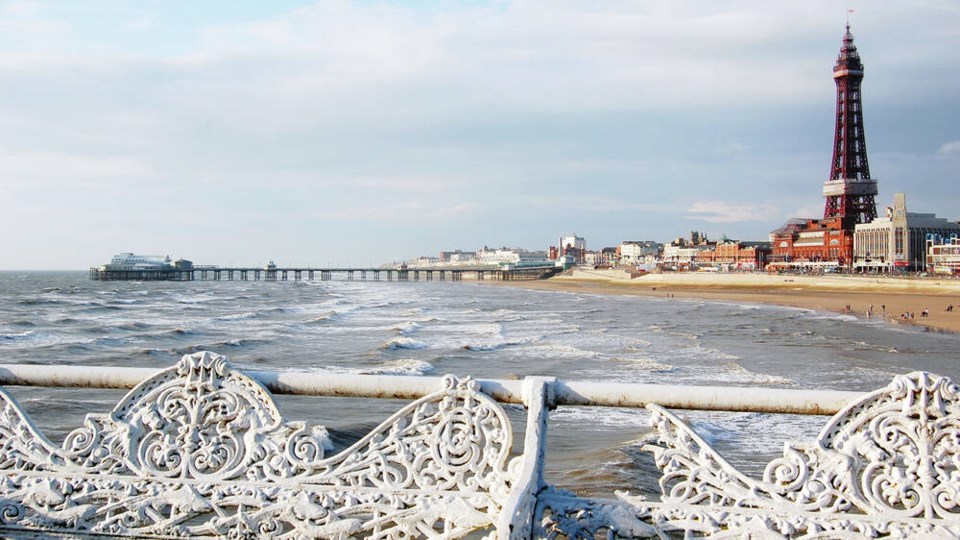When I tell my British friends I’m going to Blackpool, their expressions sour and they ask, “Oh, God, why?” For me, the answer is easy: for the joy of experiencing working-class England at play.
For over a century, until the last generation, Blackpool, located on the west coast north of Liverpool, was where the mill workers and miners of Yorkshire and Lancashire spent their holidays. Working blokes took their families to this queen of north England resorts hoping for good fun for the kids and a bit of razzle-dazzle entertainment for themselves.
Today, Blackpool’s vast beaches are usually empty—often too cold for comfort. In this era of cheap airfare between Britain and Mediterrannean Europe, warm beaches are a year-round option for even the working class.
Blackpool is dominated by the Blackpool Tower. Shaped like a stubby Eiffel Tower, this giant amusement center seems to grunt, “Have fun.” At the tip of this 518-foot-tall symbol of Blackpool is a grand view that’s just smashing, especially at sunset.
The tower’s gilded ballroom is festooned with old-time seaside elegance. A relay of organists keeps pensioners waltzing, fox-trotting, and doing the tango. Many of these dancers have been coming here regularly for 50 years. They’re happy to share an impromptu two-step lesson with any curious visitor. Many more pay to sit with their fish-and-chips and mushy peas and watch.
Leaving the ballroom, I work my way through a string of noisy amusements on the waterfront promenade. Countless greedy doors open, trying every trick to get me inside. Huge arcade halls broadcast tape-recorded laughter and advertise free toilets. The randy wind machine under a wax Marilyn Monroe flutters her skirt with a steady breeze. The smell of fries, tobacco, and sugared popcorn wafts with an agenda around passersby.
For a quick diversion, I hop a vintage trolley car to cruise the promenade. Riding the trolleys, which constantly rattle up and down the waterfront, is more fun than driving. While the old trolleys survive, the traditional horse carriages have been replaced with sugary pink Cinderella carriages. Little girls want to be princesses, and demand drives change.
Each of the three amusement piers has its own personality. Are you feeling sedate? Head to the north pier. Young and frisky? Central pier. Dragging a wagon full of children? The south pier is for you. For a peaceful side of Blackpool, I hop out at the north pier, and stroll that venerable boardwalk out to sea where the only sounds are the gulls and the wind in my hair.
In 1879, back when the north pier was new, Blackpool became the first city in England to switch on electric streetlights. Now, it celebrates this history—and stretches its season into the autumn—by illuminating its seven miles of waterfront with countless blinking and twinkling lights. The first time I saw the much-hyped “Illuminations” years ago, the American inside me kept saying, “I’ve seen bigger and I’ve seen better.” But I filled his mouth with cotton candy and just had some simple fun like everyone else on my specially decorated trolley.
For modern-day fun, Blackpool Pleasure Beach is tops. Its 42 acres of rides (more than 100, including “the best selection of white-knuckle rides in Europe”), ice-skating shows, cabarets, and amusements attract seven million people a year, making Pleasure Beach one of England’s most popular attractions. Its biggest roller coaster is among the world’s tallest (213 feet) and fastest (74 mph).
Blackpool has plenty to keep its visitors entertained in the evening. A fun part of my afternoon is deciding how I’ll cap my day: with a play or an old-time variety show. Nighttime options always a few dancing-girl, racy-humor, magic, and tumbling shows. I enjoy the corny “old-time music hall” shows, which are neither hip nor polished. It’s fascinating to be surrounded by hundreds of partying British seniors, swooning again and waving their hankies to the predictable beat. Busloads of happy widows come from all corners of north England to giggle at the racy jokes. A perennial favorite is Funny Girls, a burlesque-in-drag show that delights footballers and grannies alike.
For me, Blackpool’s top sight is its people. You experience England here like nowhere else. Grab someone’s hand and a big stick of “rock” (rock candy), and stroll. Appreciate the noisy 20-somethings pulling down their pants to show off butt cheeks reddened by new tattoos. Ponder what might inspire someone to spend his golden years here, wearing plaid pants and a bad toupee.
A British friend once told me, “Blackpool is in the DNA of north England. It’s a ritual where family memories are created and where those memories are passed through the generations. It’s a place not to see but to do. You’ve got to eat the candy, ride the carousel, dance in the ballroom, walk the pier.”
If you’re not into kitsch and greasy spoons, skip Blackpool. But if you’re traveling with kids—or still are one yourself—splash in this uniquely English puddle of fun.
This article was adapted from Rick’s new book, For the Love of Europe.
Rick Steves (www.ricksteves.com) writes European guidebooks, hosts travel shows on public TV and radio, and organizes European tours. You can email Rick at [email protected] and follow his blog on Facebook.


-thumb.png;w=120;h=80;mode=crop)
